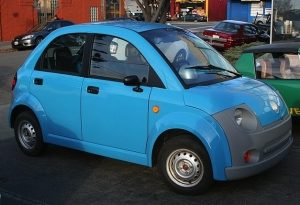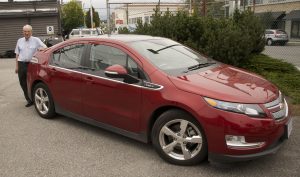By David Dodge and Duncan Kinney
If anyone has any right to be excited about driving around a new electric vehicle it’s Phil Dayson. The man has paid his dues.
He got involved with an electric vehicle company that went belly up and he drove a Selectria, a rebuilt electric version of a Geo Metro for eight years.
So when Dayson took delivery of his Chevy Volt it was like Christmas morning. Six months later Dayson’s excitement and enthusiasm about GM’s first commercial offering in the electric vehicle market is still palpable.
EV History

The Dynasty IT had a top speed of 55 km/h and was manufactured in Kelowna, B.C.
But before we get to the Volt let’s back up to Dayson , the EV pioneer. He owned a company, Commercial Body Builders that constructed the bodies for the Dynasty IT electric car. Dynasty Electric Vehicle Limited was the manufacturer and it was a B.C. based company that raised a ton of money on the Vancouver Stock Exchange, built a factory in Kelowna and even had the provincial government handing out $5,000 rebates per car. Unfortunately when Transport Canada ruled they couldn’t drive on the road due to their low top speed the company floundered.
Dayson acquired the company and ended up selling these cute-as-a-button souped-up golf carts to retirees in the Sunbelt. It was a golf cart with turn signals and some safety equipment. You can still see them on the Dynasty website, but the latest model listed is 2008. The company sold about 200 cars in its time.
This early romance with the idea of electric vehicles led Dayson to purchase his own niche electric car, the Solectria Force, essentially a rebuild of the Geo Metro. About 400 of these cars were created in the early 90s. Dayson owned his Solectria for eight years and put more than 40,000 km on it. It had a top speed of 110 km/h and had a range of up to 60 km.
Why drive an electric vehicle?

Phil Dayson used 1.5 tanks of gas to power the onboard generator and $30 worth of electricity to go 7,000 kilometers. Photo Kevin Sauvé
As Dayson gets into the bright red version of his Chevy Volt in the parkade under his office he points at the control panel.
“This sums it up right here. On this current tank of gas I have gone 2,503 km and I have used 17 litres of fuel.”
Not only that but the Chevy Volt also has the distinct advantage of not looking like a Geo Metro.
“I’ve gone 6,698 km since beginning of Dec and I’ve now used a tank and half of a gas and maybe $30 worth of electricity,” said Dayson
“That’s what it’s all about,” says Dayson. After working in the trenches for so long supporting the development of electric vehicles Dayson says “The people in the EV business in their wildest dreams never thought it would take off the way it has.”
Drive an EV and save money?
Dayson says he is asked about “payback” all the time. It’s a bit of a funny question. “No one ever asks a Cadillac owner what the payback on their vehicle is.” However, it’s worth pointing that once you fork out roughly $41,000 to purchase the Volt, operating costs are low.
To help with the sticker shock there are generous rebates as well. If you are in BC you get a $5,000 rebate on the Volt, while you can get $7,769 in Quebec and $8,231 in Ontario.
According to the US government it costs $650 a year in fuel costs to run a Chevy Volt (at twelve cents a kilowatt hour). A Honda Civic would run you $1800 a year in fuel costs. When you start talking about anything larger than a Civic the savings really start to add up. Driving an EV can also reduce your emissions by 80 per cent if you live in B.C. where 93 per cent of electricity comes from low-emission hydroelectric dams.
As for the cost, keep in mind the Toyota Prius Hybrid took 10 years to reach sales of 400,000 units and a price of $26,000. Prius has a compact model selling for as low as $21,000. After a slow 2011 the numbers do seem to be coming around, the Volt has better sales number than roughly half of all US cars and set a sales record in August of 2012.
At this stage you buy an electric car not to save money, but to help the environment, make a political statement or because you think they are cool and fun to drive, says Dayson.

Phil Dayson is an accidental electric vehicle pioneer who lives in Vancouver. He wound up owning an electric car company almost a decade ago and when the Chevy Volt came out he snapped one up. Photo Kevin Sauvé
Dayson steps on the gas to make his point, and the car does take off, but with no noise or other conventional indicators, it’s almost anticlimactic. It’s a fast car for its class, the Volt will go 0-60 in 8.3 seconds. If it’s performance you want then perhaps the Model S Tesla is the car for you. The $85,000 model can do 0-60 km/h in 4.4 seconds, a number that would give a Corvette a run for its money. This is massive step-up from the Dynasty IT. It topped out at 55 km/h and was essentially banned from the streets.
The electric car has certainly been saddled with reputation challenges over the years including battery, range and speed issues, but this new crop of electric vehicles is turning these old stories into myths.
As Dayson pulls up to restaurant in downtown Vancouver he parks at a free charging station reserved for electric cars in front of a restaurant he explains: “The last time I was here for a few hours I used 2 kWh of electricity.” That’s about $0.10 worth of electricity.
The Chevy Volt deals with “range anxiety” by adding a gas powered generator under the hood that can extend the range of the car to 600 km versus the 65 km range of a similar electric-only car.
The Environment
An electric-only car in BC saves about 80 per cent on pollution emissions over a conventional car. But surprisingly “The studies show that even if you are powering you car with electricity that comes from a pure coal-generated plant – there’s less pollution than from gasoline,” says Dayson.
Are B.C. people greener than most? This is purely anecdotal evidence but as Dayson parked his Chevy Volt behind another Chevy Volt in front of the restaurant a Toyota Prius cab drives by passing another Prius parked at the curb. Coincidence? Perhaps, but British Columbians are twice as likely to purchase hybrid vehicles compared to the Canadian average. Institutionally B.C. believes in EVs, not only do they have the generous rebate but they are set to install 450 electric charging stations across the province.
EV Choices
With the success of hybrids and high consumer satisfaction surveys for new electric cars like the Volt you can expect to see continued innovation. Here are three EVs that are available in Canada right now.
The Chevy Volt – This car has already been driven 80 million miles and saved 4.5 million US gallons of fuel. The Volt is an electric car that has a backup gas powered generator to produce electricity when you run out of charge. This extends the range to 600 km. Consumer satisfaction surveys are very positive about the Volt. The 2013 lists for $41,000 in Canada.
The Nissan Leaf – The Nissan Leaf is an all-electric vehicle with a maximum range of 160 km, a top speed of 140 km/h and a price tag of $38,395. Reviews of the car itself seem to be generally positive. The emissions will be lower for this car than the Volt, but when you run out of juice it’s time for a long coffee break at a charging station.
Mitsubishi I-Miev – The Mitsubishi I-Miev, short for Mitsubishi Innovative Electric Vehicle is an alternative to the Leaf. It’s an all-electric or so-called battery electric vehicle with a maximum range of 155 km and a price tag that starts at $34,000. The company website curiously has no information, so you’re better off looking at Wikipedia.
For people with range anxiety the Volt will work like a regular car, but electric cars may already make sense for companies with small fleets of cars that run around the city every day.
Is the electric car finally for real? Dayson scoffs at those who call electric cars a gimmick.
“We have to remember that this is the first generation of electric car. What was the first generation automobile? The Model A Ford?
“When the first cell phones came out people definitely thought they were gimmicks. Who is going to carry around a brick to be able to talk while walking down the street? Very quickly in our world gimmicks turn out to be an absolutely essential part of one’s life.”
Dayson, the EV pioneer, has done his 40 years in the desert and now, like Moses, he’s within sight of the promised land. Now it’s up customers and manufacturers to take those last few steps.
-30-
[flickrshow:72157631638496262,width=625]





